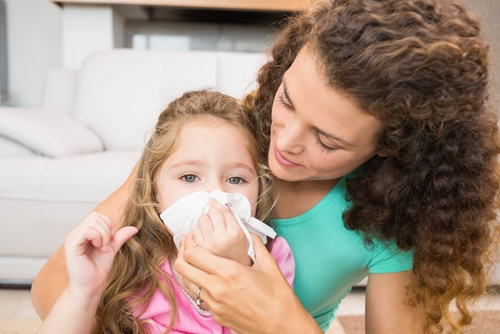Sinus might seem like common cold at first.
The child coughs, sneezes and gets a red nose, like in cold. But the difference is that sinus attack last longer than common cold. Sinuses are spaces in the bones of the face and the head which are filled with air. They are exactly located on both sides of the nose, behind the nasal cavity, within the forehead, and at the back & in between the eyes. Sinuses grow in pairs and there are four pairs of them. Sinuses begin to develop in the mother womb and grow till twenty years of age. As children have an incompletely developed immune system, they catch cold infection more frequently.
The actual purposes of the sinuses are not known, but scientists say that they make the head lightweight as these air pockets are filled with light air. If these air pockets were to be replaced with something solid, the head will become heavier. The sinuses also provide tone and depth to the voice. That is the reason why the voice sounds funny when a person catches a cold or gets a sinus attack. The sinuses are covered with a thin and moist tissue layer known as a mucous membrane. These membranes are responsible for adding moisture to the air breathed in. They also produce mucus, a sticky liquid filled in the nose, also called snot. This sticky liquid catches germs and dust, which are carried by the air, before they enter the body. The mucus membranes are covered with cilia or microscopic hair. These cilia move to and fro to encourage the flow of the mucus out of the nose and back inside. When the sinuses are infected, the membranes produce more mucus and become swollen and irritated.
When a person catches cold, the virus harms the cilia and the mucus doesn’t get swept back in. This is how a runny nose is developed. The mucus lining swells within the nose. This narrows or completely blocks the minute opening of the sinus into nose. Because of this, the stickier and thicker mucus produced get trapped in the sinuses. This stagnant mucus becomes the breeding ground for virus, bacteria and fungi. If the common cold stretches for over two weeks, the sinusitis condition develops. This condition is sinus infection.
Acute sinusitis is sinusitis stretching over two weeks or so. But when it crosses three months, it is called chronic sinusitis. The child can get mild fever along with acute sinusitis. There is no fever associated with chronic sinusitis and the symptoms are less intense. The symptoms of sinusitis or sinus attacks are mild fever, bad breath, continuous nasal discharge, puffy eyes, and daytime cough. Some children also experience low energy, crankiness, headache and pain behind the forehead, cheeks and eyes.
When the doctor is approached for help, he/she will check throat, nose and ears for infection. The sinuses are also checked. The doctor will press or tap on the cheeks and forehead. If bacteria are responsible for causing the infection, the child will be given antibiotics to kill the bacteria. The antibiotics will show their effect within few days itself. A nasal spray or decongestant can also be used to treat blocked and runny nose. If it is chronic sinusitis, the antibiotics need to be taken for a longer time period, like for about a few weeks, in order to kill the bacteria completely. The child shouldn’t stop the course of medicine if he/she isn’t seeing any improvement in the condition. The doctor should be contacted for further instructions. In this case, a surgery is an alternative. The doctor will ask the child to get a CT scan of the sinuses.
The best thing about sinusitis is that it isn’t contagious. So if a kid is infected with it, he/she can still go to school and have fun with the rest of the kids. But kids who have sinus problem should stay away from environmental pollutants and allergies, which can trigger the condition again in them.







Be First to Comment